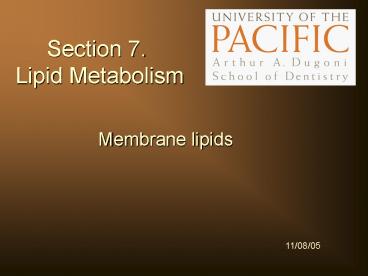Section 7. Lipid Metabolism - PowerPoint PPT Presentation
1 / 21
Title:
Section 7. Lipid Metabolism
Description:
1 Synthesis increased by ATP, NADH, acetyl CoA, citrate, insulin and malonyl CoA. ... Fatty acid chains, and then a head group, much more polar structure. – PowerPoint PPT presentation
Number of Views:60
Avg rating:3.0/5.0
Title: Section 7. Lipid Metabolism
1
Section 7. Lipid Metabolism
- Membrane lipids
11/08/05
2
Some Control Sites of Fatty Acid Metabolism
Synthesis increased by ATP, NADH, acetyl CoA,
citrate, insulin and malonyl CoA.
Oxidation increased by AMP, palmitoyl CoA,
glucagon and epinephrine.
1
3
Essential Fatty Acids
- linoleate C182 ??9??12
- linolenate C183 ??9?12?15
- arachidonate C204 ??5??8?11?14
- eicosapentaenoate C205 ??5??8?11?14?17
- These polyunsaturated fatty acids (also called
w-fatty acids) are precursors of eicosanoid
hormones. - Humans lack the enzymes needed to introduce
double bonds beyond the 9-position.
2
4
Biosynthesis of Eicosanoid Hormones
Fig. 22.30
- These families of signal molecules include a
variety of structures and have varied localized
effects. - They modulate inflammation, hemostasis, ion
transport, synaptic transmission and sleep.
3
5
Selected Eicosanoid Hormone Structures
- Synthesized intracellularly, starting with
arachidonic acid. - Bind 7TM receptors of nearby cells.
Fig. 22.31
4
6
Platelet Aggregation
- Marine and terrestrial fatty acids produce
slightly different products. - Blood platelet aggregation is sensitive to these
differences. - A2 activates
- A3 does not.
- I2 and I3 inhibit.
5
7
Aspirin Anti-Inflammatory Mechanism
Fig.12.25
- Aspirin acetylates serine 530 in a tunnel
leading to the active site of prostaglandin
synthetase, which blocks arachidonate binding. - Fewer prostaglandins and prostacyclins made.
- This also reduces thromboxane production which
makes asprin antithrombic, as well as
anti-inflammatory.
Fig.12.22
6
8
Prostaglandin H2 Synthase-1
- Membrane bound
7
9
Membrane Lipids
- Hydrophobic enough to be insoluble in water with
highly localized hydrophilic portion. - Examples are
- Phosphoglycerides??
- ??Sphingolipids
- Cholesterol (not shown) is also common in
membranes.
Stryer 4th
Stryer 4th
8
10
Lipid Bilayers
- Phosphoglycerides and sphingolipids have two
non-polar alkyl chains and a polar head group. - These amphipathic structures spontaneously form
sheet-like bilayer structures in aqueous
solutions. - The polar head groups face the water.
- The non-polar tails are not in contact with the
water.
Fig. 12.8
Fig. 12.10
9
11
Phosphoglyceride Structure
- The structure of the alcohol moiety, attached by
a phosphoester bond, is variable.
Fig. 12.3
(p 323)
10
12
Phosphoglyceride Biosynthesis
- CDP-diacylglycerol is an activated intermediate
for several phosphoglycerides. - Phosphatidate is also the precursor for
triacylglycerol.
11
13
Biosynthesis of Sphingolipids (I)
- First the palmitoyl chain is extended.
- Then it is reduced.
12
14
Biosynthesis of Sphingolipids (2)
Fig. 26.3
- A second acyl group is attached.
- A variety of polar head groups are added (see
next slide).
13
15
Sphingolipids
Fig. 26.3
14
16
Gangliosides
Fig. 26.4
- Gangliosides have at least one acidic sugar.
- Are prevalent in neural tissue.
- The number and structures of the sugars vary.
- Tay-Sachs disease is due to ?-N-acetylhexosamidase
deficiency, which inhibits ganglioside turnover.
15
(p 722)
17
Membrane Structure
Fig. 12.17
- Lipid bilayer provides membranes impermeability
to polar solutes. - Proteins determine membrane function.
- Channels, carriers, receptors, signal
transducers, pumps.
16
18
Amphipathic Molecules in Water
- Oils (left) are too hydrophobic to be
significantly soluble in water. They form
monolayers at the water air surface.
Stryer 4th
- Bilayers (see above) are formed by less
hydrophobic, but amphipathic, structures.
Typically they have two acyl chains.
- Structures with one acyl chain (right), such as
fatty acids and some detergents, form micelles.
Examples of micelle function are fat uptake (in
vivo) and protein isolation (in vitro).
17
Fig. 12.9
19
Vesicles
- Vesicles are small spherical bilayer
structures. - They are produced in vivo and in vitro.
Fig. 12.12
- Dentin matrix vesicles have a role in dentin
formation. - Acetyl choline release is via vesicles.
- Membranes are isolated as vesicles for
experimental study. - Targeted drug and gene delivery by vesicles is
being developed.
18
20
Detergents
- Water soluble, with substantial hydrophobic
portions. - Binds to hydrophobic portions of other molecules
and makes them soluble in water. - Bile salts and soaps are detergents.
- Chlorhexidine is strong enough to solubilize oral
bacterial membranes. - Other detergents are gentle enough to solubilize
membrane enzymes without denaturation.
19
21
- Web links
- Lipids and Membranes. A web page reviewing the
topic. - Next topic Steroids































